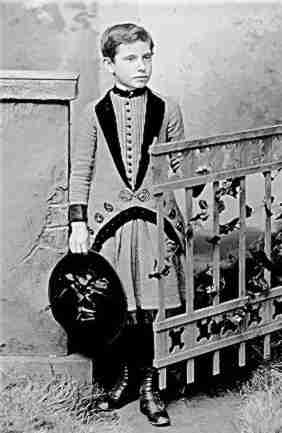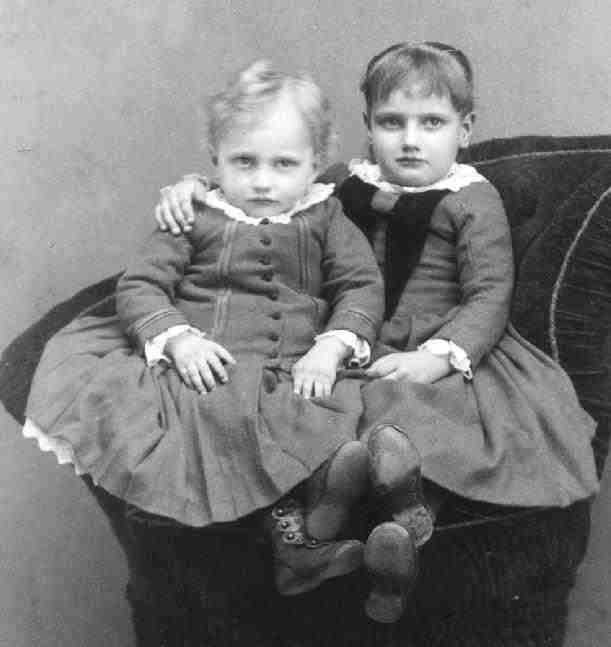
Boy Dress Styles: Front Buttons

Figure 1.--Boys in the late 19th Century began wearing plainer, less fancy dresses. Not all boys, however, wore these specialized boy dresses. Some mothers preferred quite elaborate dresses for their sons. This boy wears an elaborate dress, but note the front buttons and lapels--both boyish features. I do not have the date of this photograph, but would estimate 1875-85. He appears to be wearing a plaid skirt or pantalettes under his dress. Note his hat with flowers or decorations on the crown with a very wide, but short streamer.
|
Front buttoning bodices were another common element in boys' dresses. This is a major design difference between boys' and girls' dresses. Ladies Home Journal instructed mothers, "Little boys' dresses button up the front, those of their sisters fasten in the back." [Ladies Home Journal , March 1895] The girl's dresses almost always buttoned down the back. Front buttons while not completely unknown in girls' dresses, were far more common in the dresses worn by boys. One can speculate about the reason for these differences. One fashion historian suggests that girls were expected ti rely upon the assustance of others. Girls from affluent family were expected to get help from their mothers, nannies, or sevants to dress. Boys were, however, expected and incouraged to become independent-- and this included learning how to dress themselves early on. This explanation is not as clear as one might expect. For one thinf some popular styles for boys were compicated to put on, styles like Little Lord Fauntleroy suits, for example, necesitated that the boy be helped. While the fancy Fauntleroy suit was perhaps an exception, it should be noted that wealthy 19th Century men had gentlemen's gentleman to help them dress. Even so the principal pont that boys were encourged to be independent and girls were not is valid.
Style
Front buttoning bodices were another common element in boys' dresses.
Garments
Dresses are not the only skirted garments that boys wore. Buttons were handled differently with these garments.
Dresses
Buttons were employed in many different stylistic ways. Some times they were purely ornamental. However employed, they were much more common on boys' dresses than girls' dresses.
Kilts
The kilt suits American boys wore had front buttoning jackets and vests. In some cases very large numbers of buttons were employed.
Smocks
Early smocks were made for boys and girls all with back buttons. After World War II (1939-45_, smocks declined n popularity on the Continent. Boys that did continue to wear smocks began wearing stkustically different ones. Often smocks styled for boys had side or front buttons. Girls continued to mostly wear back buttoning smocks.
Conventions
Front buttoning dresses are a major design difference between boys' and girls' dresses. Ladies Home Journal instructed mothers, "Little boys' dresses button up the front, those of their sisters fasten in the back." [Ladies Home Journal , March 1895]

Figure 2.--Note the elaborate front buttons on this little boys' dress. Also note that he and his sister have identical reffled collars and cuffs. He also wears a petticoat under his dress. These American child were photographed in Minnesota--probably about 1895.
|
Prevalence
The question is just how prevalent this stylistic difference is. Girl's dresses seem to almost always buttoned down the back. Front buttons while not completely unknown in girls' dresses, were far more common in the dresses worn by boys. This is a prelimary HBC assessment, but it requires much additional investigation. HBC is also in the process of looking for girls' dresses with front buttons. When we find some we will post them here. We will also post images of boys with or without front buttoning dresses to assess just how useful this factor is in interpreting old photographs.
Reason
One can only speculate about the reasons for this difference. It may have been purley stylistic, but style can be rooted in paractical differences. One fashion historian suggests that girls were expected to rely upon the assustance of others. Girls from affluent family were expected to get help from their mothers, nannies, or sevants to dress. Boys were, however, expected and incouraged to become independent-- and this included learning how to dress themselves early on.
This explanation is not as clear as one might expect. For one thinf some popular styles for boys were compicated to put on, styles like Little Lord Fauntleroy suits, for example, necesitated that the boy be helped. While the fancy Fauntleroy suit was perhaps an exception, it should be noted that wealthy 19th Century men had gentlemen's gentleman to help them dress. Even so the principal pont that boys were encourged to be independent and girls were not is valid.
Christopher Wagner

Navigate the Historic Boys' Clothing Web dress pages:
[Return to the Main boy dress page]
[Pinafores]
[Ringlet curls]
[Smocks]
[Bodice kilts]
[Kilts]
[Fauntleroy dresses]
[Sailor dresses]
[Fancy dresses]
[Dresses: 16th-18th centuries]
[Dresses: Early-Mid-19th century]
[Dresses: Late-19th century]
[Dresses: Early 20th century]
[Difficult images]
[Movie dresses]
Navigate the Boys' Historical Clothing Web Site:
[Introduction]
[Activities]
[Bibliographies]
[Biographies]
[Chronology]
[Clothing styles]
[Contributions]
[Countries]
[Boys' Clothing Home]
Created: September 13, 2000
Last updated: September 13, 2000




